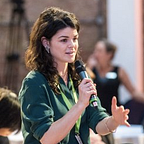How to pivot properly — linear ideation
The lean startup movement has made ‘pivoting’ a standard part of idea development. The pivot has become a positive thing — no longer is it seen as a failure to be working on the wrong idea, it is a founder’s badge of honour.
However, we need to better define what pivoting means and ensure it is a process that increases an idea’s value, rather than destroying it.
Pivoting is based on the idea that by gathering more data you can make a better judgment about whether your idea is valuable. Ideas are no longer a static entity — they are a starting point which is tested, iterated and corrected until you reach product-market fit.
There are two types of pivots — those that destroy value and those that create value.
Value destroying pivots
When it becomes clear that the direction your idea is heading is not as valuable as you had first thought, it’s time to pivot. Maybe you have had negative feedback from customers or maybe you have learnt how competitive the market is.
Some founders react to this by ‘pivoting’ to a new idea i.e., they drop their existing idea and move onto the next item on their ‘idea list’. Often this ‘pivot’ has no connection to the previous idea that the founders were working on.
This has a real cost.
Every time you ‘pivot’ in this way, you are discarding important assets that you have created; the knowledge, the contacts and the technology that you have built. You go back to square one every time you pivot like this.
For example, a founder that first tries to tackle improving data analysis for consultants before realising that consultants already have good in house systems for this. They then ‘pivot’ down the idea list and explore making sales teams more effective. It turns out the space is highly competitive. So they ‘pivot’ again…
With each pivot they lose the skills, knowledge and connections they have built, and instead start from scratch.
Positive pivots = Linear ideation
So how should we think about pivoting?
A useful mental model for how to pivot well is to think of it as linear ideation.
Linear ideation helps you to recognise and then capitalise on the assets you are creating through the ideation process.
You start with the basis for your idea (read here about edge to see how we create ideas at Entrepreneur First) and go through the usual customer development cycle, seeking input from customers and gathering feedback. Instead of looking for your idea to fail, you’re looking for the upside — what can you learn from these interactions that allow you to edit and update your idea?
As you spend more and more time in the space, you become a deeper expert. Many founders win by being experts in niche problems. As you go through the process of testing your idea, you build your knowledge about the domain you’re working on, you develop your network and you start building a product. At each pivot, you use these assets to make an informed decision about the direction the company should take.
For example, you want to provide a better way for people to manage their mortgage. You soon find out, from speaking to potential customers, that managing mortgages isn’t an issue. But customers did mention about the purchasing process and what a pain it was. You then go and explore this issue.
This may seem logical, but many founders will give up on this process after the first 3–4 pivots. The best founders will persevere and build on their asset base, developing further niche knowledge and using the network they have already built to move fast.
No idea is perfect.
It’s only through iteration and testing that you can get to a ‘good’ idea. But it also requires perseverance and a recognition of the value you have created by going through this process. The best founders we work with recognise that and use it to their advantage.
Building a startup is a constant learning process and how you use your learnings to pivot will affect your final outcome.
If you’re interested in finding out more how linear ideation and how we work at Entrepreneur First, read on here
Alice Bentinck is Co-Founder of Entrepreneur First (EF.) EF runs full-time programmes that fund the most talented scientists, engineers, developers and industry experts to find a co-founder, then helps those teams grow their businesses and raise funding. We’ve built >100 companies worth >$1B so far.
We currently run programmes in Berlin, Singapore and London, you can apply here or sign up below to get advice from the EF team on your startup journey.
